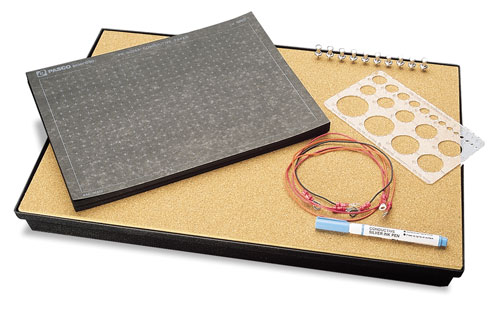Description
Start by investigating standard electrostatic configurations, such as point sources, dipoles, and capacitors. Then go further. You might, for example, investigate whether a person is safe in a car, under a tree, or on top of a flag pole in a thunder storm. Or you might create an electrostatic model of fluid flow to show that water flows fastest in the narrowest portion of a hose.
Features
- Complete kit
- Complete manual
- Measure electric fields directly
- Measure potentials directly
- No mess
- Inexpensive
- Easy storage
Typical Experiments
- Dipoles of Like Charges
- Dipoles of Opposite Charges
- Parallel Plate Capacitor
- Point Source and Guard Ring (cylindrical capacitor)
- Floating Electrode
How It Works
With this kit students can map both the potentials and the electric fields around any conceivable system of two-dimensional charged conductors. The procedure is simple:
- Draw any electrode
- Plot the equipotentials
- Plot the electric field
What’s Included
- 50x Conductive paper with cm grid: 23 x 30 cm (50 sheets)
- 10x pushpins
- 3x wires
- 1x Conductive ink pen and circular template
- 1x Plastic tray with corkboard top: 32 x 48 cm
- 1x Instruction manual with 10 experiments
Product Specifications
| Conductive Paper with grid | 23 x 30 cm (50 sheets) |
| Plastic Tray | 32 x 48 cm |
Required Accessories
| 1x Basic Digital Multimeter | SE-9786A | |
| 1x Triple Output Power Supply | SE-8587 |
Experiment Library
Perform the following experiments and more with the Field Mapper Kit.
Visit PASCO’s Experiment Library to view more activities.




